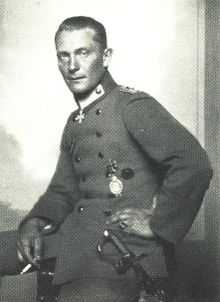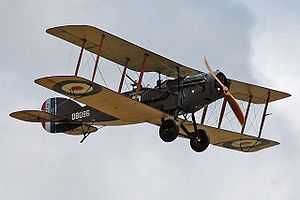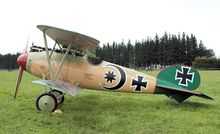Desmond Uniacke
| Desmond Percival Fitzgerald Uniacke | |
|---|---|
| Born |
18 December 1895 Chelsea, Middlesex, England |
| Died |
25 March 1933 (aged 37) Middlesex, England |
| Allegiance |
|
| Service/branch |
|
| Rank | Second Lieutenant |
| Unit |
Royal Inniskilling Fusiliers No. 48 Squadron Royal Flying Corps |
Second Lieutenant Desmond Percival Fitzgerald Uniacke (18 December 1895 – 25 March 1933) was a World War I British flying ace credited with thirteen aerial victories. He was captured after engaging in aerial combat with Hermann Göring, commander of Jasta 27.
Background
Desmond Percival Fitzgerald Uniacke, second son of Richard Gordon Fitzgerald Uniacke and his wife Cecilia Monica Lambert, was born on 18 December 1895 at 16 Tite Street in Chelsea, Middlesex, England. He was baptized at Saint Barnabas' Church in Pimlico, Middlesex on 16 January 1896.[1] Desmond was one of five children, three of whom survived to adulthood.[2] He was educated at Saint John's College in Hurstpierpoint, West Sussex, England.[1] His father Richard Uniacke (1867–1934) was a librarian, archivist and genealogist. He served as assistant librarian of printed books at the College of Arms.[2]
Military career

There is disagreement over whether Desmond Uniacke initially served with the Royal Irish Rifles[2] or the Royal Inniskilling Fusiliers.[3] The Supplement to the London Gazette of 23 December 1914 announced his appointment as temporary second lieutenant.[4] On 23 September 1916, Uniacke was promoted to second lieutenant. He transferred to the Royal Flying Corps in May 1917 and was posted to the No. 48 Squadron. Desmond Percival Fitzgerald Uniacke is credited with thirteen aerial victories.[3][5] All of them occurred while he was an observer in the Bristol F.2b, also known as a Bristol Fighter. In addition, all thirteen were in conjunction with one pilot, Second Lieutenant Ralph Luxmore Curtis.[3]
Desmond Uniacke scored his first aerial victory from his Bristol F2.b with serial number A7149. He and his pilot Curtis sent a two-seater out of control over Quéant, Pas-de-Calais, France on 3 Jul 1917. Two days later, from Bristol F.2b (A7153), Uniacke and Curtis sent an Albatros D.V out of control over Bapaume, Pas-de-Calais.[3] Uniacke scored his third aerial triumph from his Bristol F.2b (A7107) when he and pilot Curtis destroyed an Albatros D.V over Vitry, France on 7 July 1917.[6]
Later that month, on 28 July 1917, Uniacke and Curtis in Bristol F.2b (A7121) sent an Albatros D.III out of control over Ghistelles. Second Lieutenants Uniacke and Curtis achieved a double victory (fifth and sixth for Uniacke) on 16 August 1917 from their Bristol F2.b (A7151). During aerial combat with two Albatros D.V aircraft, one was destroyed in flames and the other sent out of control, both over St. Pierre and Capelle, Nord, France.[3]
The next four victories (7 through 10) for Uniacke were all from Bristol F.2b (A7224). On 20 August 1917, Uniacke scored his seventh aerial victory when he and aviator Curtis sent an Albatros D.V out of control over Ghistelles. Only two days later, Uniacke had a double victory when he, with Curtis as pilot, destroyed one Albatros D.V and sent another out of control, over Ostend, West Flanders, Belgium. His tenth kill occurred on 2 September 1917, when he and pilot Curtis sent an Albatros D.V out of control east of Diksmuide, West Flanders, Belgium.[3] That victory was shared with the crew of Bristol F.2b (A7170), pilot Lieutenant Keith Rodney Park of New Zealand and observer Second Lieutenant Alan Douglas Light of England, both of them also flying aces.[7][8]
On 5 September 1917, Uniacke and Curtis, from their Bristol F.2b (A7170), sent a DFW C out of control over Middelkerke, West Flanders. Uniacke had his twelfth aerial triumph on 14 September 1917 from his Bristol F.2b (A7224) when, with Curtis as pilot, he defeated an Albatros D.V, destroying it over Ghistelles. His final victory took place on 17 September 1917 when, with Curtis in their Bristol F.2b (A7224), he sent a two-seater out of control over Leke, West Flanders. That was shared with the crew of Bristol F.2b (A7222), Sergeant J Oldham as pilot and Second Air Mechanic William Walker, also an ace, as observer.[3][9]
On 21 September 1917, observer Second Lieutenant Desmond Uniacke and his pilot Second Lieutenant Ralph Curtis engaged in aerial combat with pilot Hermann Göring, commander of Jasta 27. The confrontation took place over Sleyhage, near Roeselare, West Flanders, also known as Roulers. At 0905, their Bristol F.2b was shot down by Göring.[10] Curtis died later that day from the wounds he had sustained in combat.[6] Uniacke was captured and became a prisoner of war.[11][12]
After the War
Uniacke married Beatrice Mary Swetenham Johnstone (1901–1975),[13] daughter of Arthur Oliver Johnstone, in 1920 in Sussex, England.[14] Prior to his death, he resided at 7 Normand Mansions on Normand Road in West Kensington, London. His occupation was that of wine salesman. He died on 25 March 1933 in Middlesex, England.[15][16][17] His former wife had remarried prior to his death. Her name at the time of probate on 2 June 1933 was Beatrice Mary Swetenham Hicks-Beach.[15] She had married William Guy Hicks-Beach in 1932.[18]
Gallery of aeroplanes
-

He scored all of his victories from the Bristol F.2b
-

He scored one of his victories against an Albatros D.III, #4
-

He scored nine of his victories against the Albatros D.V
References
- ↑ 1.0 1.1 Joseph Jackson Howard; Frederick Arthur Crisp (1897). Visitation of Ireland. Genealogical Publishing Comp. p. 91. ISBN 978-0-8063-0543-1. Retrieved 26 March 2012.
- ↑ 2.0 2.1 2.2 Arthur Charles Fox-Davies, ed. (1929). Armorial families: a directory of gentlemen of coat-armour (Volume 2) (7th ed.). Hurst & Blackett. p. 1985. Retrieved 26 March 2012.
- ↑ 3.0 3.1 3.2 3.3 3.4 3.5 3.6 Uniacke, Desmond. "Aces". theaerodrome.com. The Aerodrome. Retrieved 26 March 2012.
- ↑ Uniacke, Desmond Percival Fitzgerald (23 December 1914). "Supplement to the London Gazette". London Gazette (The London Gazette): 11029. Retrieved 26 March 2012.
- ↑ Jon Guttman; Harry Dempsey (18 September 2007). Bristol Fighter Aces of World War I. Osprey Publishing. pp. 18, 92. ISBN 978-1-84603-201-1. Retrieved 26 March 2012.
- ↑ 6.0 6.1 Jon Guttman; Harry Dempsey (18 September 2007). Bristol F2 Fighter Aces of World War I. Osprey Publishing. p. 15. ISBN 978-1-84603-201-1. Retrieved 26 March 2012.
- ↑ Park, Keith. "Aces". theaerodrome.com. The Aerodrome. Retrieved 26 March 2012.
- ↑ Light, Alan. "Aces". theaerodrome.com. The Aerodrome. Retrieved 26 March 2012.
- ↑ Walker, William. "Aces". theaerodrome.com. The Aerodrome. Retrieved 26 March 2012.
- ↑ Göring, Hermann. "Aces". theaerodrome.com. The Aerodrome. Retrieved 26 March 2012.
- ↑ Jon Guttman; Harry Dempsey (18 September 2007). Bristol F2 Fighter Aces of World War I. Osprey Publishing. p. 18 (partial). ISBN 978-1-84603-201-1. Retrieved 26 Mar 2012.
- ↑ Jon Guttman; Harry Dempsey (18 September 2007). Bristol F2 Fighter Aces of World War I. Osprey Publishing. p. 18 (partial). ISBN 978-1-84603-201-1. Retrieved 26 Mar 2012.
- ↑ Hicks-Beach, Beatrice Mary S. "England & Wales, Death Index: 1916–2005". ancestry.com. England and Wales Civil Registration Indexes. General Register Office (as re-printed on Ancestry.com).
- ↑ Uniacke, Desmond P F. "England & Wales, Marriage Index: 1916–2005". ancestry.com. England and Wales Civil Registration Indexes. General Register Office (as reprinted on Ancestry.com).
- ↑ 15.0 15.1 Uniacke, Desmond Percival Fitzgerald (9 June 1933). "The London Gazette". The London Gazette (The London Gazette): 3926. Retrieved 27 March 2012.
- ↑ Uniacke, Desmond Percival Fitzgerald. "England & Wales, National Probate Calendar (Index of Wills and Administrations), 1861–1941". ancestry.com. Calendar of the Grants of Probate and Letters of Administration made in the Probate Registries of the High Court of Justice in England. Principal Probate Registry (as re-printed on Ancestry.com).
- ↑ Uniacke, Desmond P F. "England & Wales, Death Index: 1916–2005". ancestry.com. England and Wales Civil Registration Indexes. General Register Office (as re-printed on Ancestry.com).
- ↑ Johnstone, Beatrice M S. "England & Wales, Marriage Index: 1916–2005". ancestry.com. England and Wales Civil Registration Indexes. General Register Office (as re-printed on Ancestry.com).